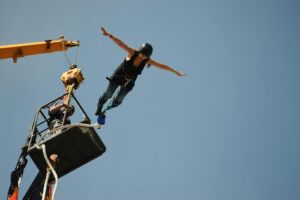- Build and use equations and formulas that aren’t straight lines to solve real-life problems.
In 2014, Margit Tall made history in Helsinki, Finland. At age [latex]95[/latex], she became one of the oldest bungee jumpers in the world, taking a thrilling plunge from a crane [latex]150[/latex] meters above the sea.

Before attempting a bungee jump, it’s crucial to understand the physics behind the experience. Each jump consists of two main phases:
- The freefall phase, where you drop straight down
- The cord stretch phase, where the bungee cord gradually slows your descent
For a [latex]150[/latex]-meter jump height, the initial freefall distance is [latex]55[/latex] meters before the cord begins to stretch. Let’s calculate how long this freefall phase lasts using the physics equation for falling objects:
[latex]\Delta x = v_it + \frac{1}{2}at^2[/latex]
Where:
- [latex]\Delta x[/latex] is the freefall distance
- [latex]v_i[/latex] is the initial velocity
- [latex]t[/latex] is the time in seconds
- [latex]a[/latex] is the acceleration due to gravity
After experiencing the initial freefall, the jump enters an exciting new phase. The bungee cord begins to stretch and slow the descent. Then, like a giant elastic band, it launches upward! This creates a series of bounces, with each rebound becoming progressively smaller until eventually come to rest.
Safety and equipment maintenance are crucial parts of bungee operations. At the end of each day, the bungee cords need to be carefully inspected, cleaned, and properly stored to maintain their reliability and elasticity.
At the Helsinki bungee site, Dana and Chen are responsible for this important safety task. Working independently:
- Dana can complete the inspection and storage in [latex]3[/latex] hours ([latex]180[/latex] minutes)
- Chen can complete the task in [latex]3[/latex] hours and [latex]45[/latex] minutes ([latex]225[/latex] minutes)